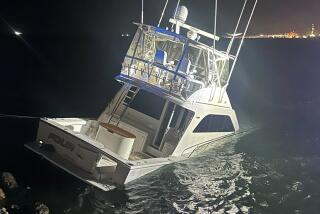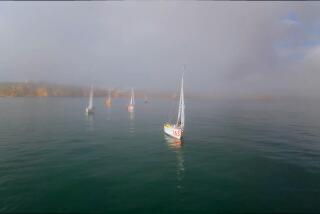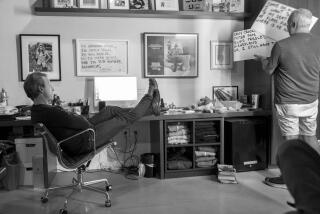Never a Lull Moment for These Sailors
- Share via
It’s 10:15 p.m. and all’s well with Ed Meyers. The captain of the Entertainer is angling the 153-foot vessel into its slip, bringing a three-hour dinner and dancing cruise on Newport Harbor to a close.
Standing behind the ship’s wheel in a classically cut blue suit with four stripes on the sleeve, the 49-year-old seaman looks every bit the captain. But before donning the uniform, Meyers tended to such necessary tasks as monitoring repairs to a navigation instrument, climbing through a hot and noisy hold to check the yacht’s twin Detroit Diesel engines, and running crew members through an impromptu safety drill.
After donning his captain’s uniform, he coordinated food and beverage service with the maitre d’ and then stood by the rail to welcome nearly 50 guests on board. He spent the better part of an hour schmoozing with them in the dining room, and was back at the rail at journey’s end to wish patrons a good night. When the vessel was empty, he grabbed a quick dinner before diving into a pile of post-cruise paperwork.
“There’s a lot more to being a captain than standing in the wheelhouse and driving the boat,” said Rags Laragione, president of the Maritime Institute, a San Diego-based company that trains and certifies about 40 boat captains each month at its 19 West Coast locations. “Sometimes it means hurrying to get all that diesel grease out from under your fingernails just in time to look pretty for the passengers,” Laragione said.
The nautical gods were smiling on this cool and clear evening early in early March. The last of the winter’s rainstorms had cleared out a few days earlier. Fog and the dangerous Santa Ana winds remained in check. The night’s guests were equally cordial; no alcohol-fueled disasters threatening to jump overboard or punch out the waiters. Despite moderate traffic in the narrow bay, the waters remained clear of nautical cowboys.
Meyers has seen his share of bad days on the scenic bay, where he captains four yachts operated by San Francisco-based Hornblower Cruises & Events.
“One New Year’s Eve, there was so much fog I couldn’t see that flag on the bow,” Meyers said. We were strictly on radar until two hours into the cruise when 50-mile-per-hour Santa Ana winds kicked in.
On another cruise, Meyers unsuccessfully tried to calm down an increasingly belligerent customer who appeared to be under the influence of drugs. When the man threatened crew members, Meyers made a call to the Harbor Patrol. He wanted the police boat to pull alongside and take the man in custody. But he waited until the boat reached the dock out of fear that the man’s pregnant wife might suffer an injury during an at-sea transfer.
If waiters and the maitre d’ determine that customers have had too much to drink, Meyers will enforce their decision to cut off drinks. Sometimes he escorts inebriated guests to a quiet corner, where he politely informs them that their behavior is bothering other guests.
During warmer weather, he’s occasionally called upon to stop would-be jumpers from making a dangerous leap into the bay. “I tell them that, not only are you going to get cold and wet, you might get hurt--and then you’re going to get arrested.”
Sometimes, the captain makes tough decisions even before the yacht backs away from its slip behind the Hornblower office on Pacific Coast Highway. On this night, Meyers delayed the departure for a few minutes because several important guests weren’t on board. Mindful of paying customers who were expecting a full, three-hour cruise, he eventually ordered the first officer to drop lines securing the yacht.
Winds and currents determine how many six-mile circuits the Entertainer must make in the narrow Newport Harbor to fill out a three-hour cruise. The Entertainer won’t go faster than four miles per hour on this night. That’s fast enough to give spectators a constantly changing view, but not so fast that the vessel will have to make several passes through the small harbor.
Meyers constantly monitors noise levels from Vini Turturro’s one-man band to ensure that the Entertainer doesn’t provide ammunition to Newport Harbor residents who view commercial boat traffic as a nuisance. The ship radio crackles with reports from other cruising vessels, as well as the occasional call for assistance from private boat operators who’ve lost their way or need assistance.
On this lazy night, the most demanding moments come when Meyers expertly threads the Entertainer between the aging boats that, like clockwork, ferry cars between Balboa Island and Balboa Peninsula. The cruise is a milk run compared with those conducted during the winter holiday season, when the cruise company generates 25% of its revenue in Newport Beach.
“You’ve got 150 to 200 boats in the Christmas parade and another 1,000 boats watching them,” Meyers said. “The houses on shore are lit up like Christmas trees, so it’s hard to tell where the land ends and the boats start.”
Tension levels rise, Meyers said, when inexperienced operators of private boats fail to follow navigation rules.
On a busy night, Meyers is responsible for the safety of as many as 575 passengers and more than a dozen crew members. He is the guardian of a vessel valued at between $2 million and $3 million. He’s also an ordained minister - as are all of Hornblower’s captains - and has performed more than 80 marriages since becoming a captain in 1994.
The rate of pay for that level of responsibility falls somewhere between $25 and $30 per hour, depending upon gratuities, according to Laragione.
“I’d guess that most dinner cruise and harbor excursion captains are part-timers,” Laragione said. “If you can get a full-time job, you can get benefits and make a living. But you’re never going to get rich.”
Hornblower’s Newport Beach operation counts just two full-timers among its eight captains. One part-timer is a lifeguard, another is a general contractor. When Hornblower recently advertised for a full-time captain, Meyers had to pull the advertisement because of the unexpectedly high response rate.
Many would-be captains hope to build upon U.S. Navy experience. Laragione’s firm recently certified the former commander of a U.S. Navy aircraft carrier, who, according to Department of Transportation regulations, needed a civilian license before taking the helm of a commercial boat. Some captains are working their way through college; others hope to work their way up from deckhand jobs on fishing boats.
Captains who earn Department of Transportation certification typically find full-time work on tug boats, research vessels and ocean-going vessels that ferry supplies to oil platforms. Many of them gain experience by skippering “six packs,” small boats that carry sports fishermen off of California’s coast.
The harbor excursion and dinner-dance cruise business is seasonal in nature, even in warm climates, so lines form quickly when full-time jobs open. Meyers credits his rise to the captain’s chair as “being in the right place at the right time.”
Meyers began a career in sales and marketing after serving in the U.S. Navy during the late 1960s and early 1970s. He’d fooled around on boats as a teenager, but never really thought about making a living on the water until 1991, when he opted for a career change.
“I left behind considerable money,” Meyers said. He paged through the Yellow Pages and began making calls to cruise operators.
The fastest way on board, he realized, was through the food and beverage department, so he signed on as a waiter. He welcomed guests, served drinks and “made sure kids weren’t hanging out the windows. ... “It wasn’t in the direction I ultimately wanted to go, but I figured it was a foot in the door.”
Along the way, Meyers handled lines when the boats docked and learned about the power plant, safety and communications devices. Gradually, he accumulated the 720 “sea days” needed to qualify for the Department of Transportation certificate.
With his captain’s papers in hand, Meyers became a first officer on smaller boats. At one point, he agreed to transfer back into the food and beverage department. In April 1994, he signed on as captain on the Wild Goose, a smaller yacht formerly owned by actor John Wayne that now is operated by Hornblower. He later became captain of The Entertainer, a much larger vessel.
Meyers managed to turn the captain’s slot into a full-time job by becoming port captain -- a job that involves a heavy volume of paperwork, maintenance tasks and, increasingly, searching for ways to cut operations and fuel costs.
Meyers views his shore duties as a double-edged sword. He’s a full-time employee earning benefits and vacation days, but he is spending less time on the water.
“It’s hard to put in all the hours I’d need to in order to stay active on the water and still maintain a normal lifestyle,” Meyers said. “This gets in your blood. You start playing around with boats as a kid, and you decide to pursue it as a career. That’s why a lot of the guys are part-timers. It”s a great way to stay on the water.”
More to Read
Sign up for The Wild
We’ll help you find the best places to hike, bike and run, as well as the perfect silent spots for meditation and yoga.
You may occasionally receive promotional content from the Los Angeles Times.






